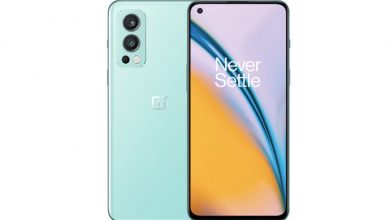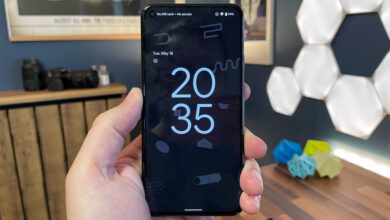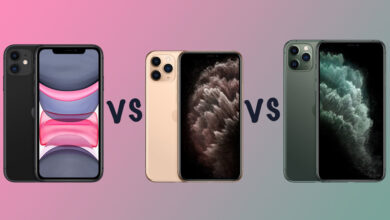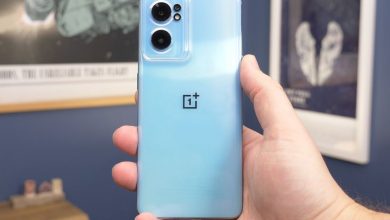OnePlus Nord CE 2 vs OnePlus Nord 2: What’s the difference?

[ad_1]
(Pocket-lint) – The OnePlus Nord is one of OnePlus’ most successful phone ranges to date, seeking to offer high performance phones at an affordable price. We’re now up to the second flagship Nord, and that means it’s about time for a stripped down Core Edition. That’s where the newly announced Nord CE 2 comes in.
Like when OnePlus announced the original Nord CE, the CE 2 is designed to offer a distilled experience of the Nord 2. But does it succeed, or should you go for the proper Nord instead?
Design
- CE 2: 160.2 x 73.2 x 7.8mm – 173g
- Nord 2: 158.9 x 73.2 x 8.3mm – 189g
- CE 2: Glass front, plastic back and sides
- Nord 2: Glass front and back, plastic sides
- CE 2: Gray Mirror, Bahama Blue
- Nord 2: Gray Sierra, Blue Haze, Green Wood, Pac-Man Edition
Despite some similarities between these two phones, there are enough visual distinctions to keep you from being confused about which is which.
OnePlus has been keen to point out that this is its thinnest phone since the OnePlus 6T, but don’t let that fool you into thinking it’s small. It’s actually slightly taller than the Nord 2, primarily because it has a chunkier bezel (or chin) at the bottom of the display.
Still, at 7.8mm thick, it is slightly slimmer than the 8.3mm OnePlus Nord 2. You can feel it, but it’s not all that different in the hand. It’s also a little lighter. But again, not enough to make a massive difference to the experience.
It’s when you look around the edges, at the buttons and ports that you see the hardware that makes the most difference to the experience of using both phones.
Nord CE 2 has both 3.5mm port and a microSD card slot. Plus, that SD card slot is in a tray that also has space for two SIMs. So you don’t have to choose between expanding storage and having a dual SIM setup.
Nord 2 has dual SIM, but no memory expansion and no 3.5mm audio port. It does, however, have the alert slider switch, which is one of the most convenient ways to switch between ring, vibrate and silent modes on your phone.
It’s on the back you get the most easily visible difference, especially when you look at the camera housing. While the Nord 2 has this neat little aluminium panel with chamfered edges, the CE 2 has this transparent area that curves up from the back of the phone. It’s moulded from the same piece of plastic as the rest of the rear panel, where the Nord 2 has glass. That means they feel quite different, and the plastic is far more prone to collecting fingerprint smudges.
Display
- Both: 6.43-inch AMOLED display – fullHD+ (1080 x 2400)
- Both: HDR10+ support – 90Hz refresh rates
- Both: OxygenOS 11 based on Android 11
We won’t spend too long on the display, because – for all intents and purposes – the two phones have a pretty much identical screen. Both have a 6.43-inch fullHD+ AMOLED panel capable of reaching up to 90hz refresh rates and support HDR10+. Both also coated in Gorilla Glass 5.
Watching them side-by-side, it’s no surprise that it’s really difficult to see any significant difference in the way they show colour, light, sharpness and shadows. Regardless of streaming platform or service, they’re very very similar.
The one slight difference – and it is very slight – is that (with both in the same default vivid settings) the Nord CE 2 screen seems slightly cooler and cleaner, with the Nord 2 featuring an ever so slightly warmer tone. Both are bright, adequately sharp and – thanks to HDR10+ support – great for watching all your favourite shows and movies on.
The one part that does make a difference when watching movies or videos is the sound. Nord CE 2 plays its audio through a single loudspeaker on the bottom edge, where the Nord 2 plays it through a speaker near the top as well, so you get more of a stereo effect from it.
In truth, neither has particularly good quality sound. They can be loud, but tend to distort if you turn them up.
Performance and battery
- CE2: Mediatek Dimensity 900 5G processor
- Nord 2: Mediatek Dimensity 1200 processor
- CE 2: Expandable storage
- Both: 8GB RAM, 128GB storage
- Both: 4500mAh battery with 65W fast charging
Again, when looking at performance and battery life there are very clear similarities between the Nord 2 and Nord CE 2. They do have different processors though. The Nord 2 has the MediaTek Dimensity 1200-AI chipset, where the Nord CE 2 has the Dimensity 900. That’s essentially a step down in terms of processing power.
You can see it, but only if you have the two phones side by side. When loading games, the Nord 2 seems to load ever-so-slightly quicker than the CE 2. We’re talking fractions of a second here, but it’s a pretty consistent result, regardless of which game we load.
Once you’re in the game, however, it’s hard to tell the two apart. Both feel fast and responsive, which is great for phones in this price bracket. Neither feels slow or laggy. If there’s any difference in fluidity and response times for touch gestures, it’s not easy to see. Even when you load up benchmarking tools like Geekbench, the difference in scores is relatively small.
squirrel_widget_5766558
Battery life is virtually identical too. Again, no surprise, given that they have the same capacity, virtually the same software and very similar hardware. They can both comfortably get through a full day, even on the busy days. On our typical days with a couple of hours screen time, both tend to finish the day with somewhere around 40 per cent left over after unplugging first thing in the morning.
Charging speed is the same too, with both supporting the 65W fast charging. Now no longer called Warp Charge, instead, using Oppo’s SuperVOOC branding.
Camera
- Both: Triple camera system
- CE 2: 64MP main camera – 8MP ultrawide – 2MP macro
- Nord 2: 50MP main camera – 8MP ultrawide – 2MP mono
On to cameras, and here’s where there is a slight difference. Where the Nord 2 has a 50-megapixel main camera, the Nord CE 2 has 64-megapixel. They both – of course – do pixel binning to get that resolution down: to 12-megapixels and 16-megapixels respectively. Ultrawide cameras are both 8-megapixel, and the third cameras are practically useless on both. Nord 2 has a monochrome, CE 2 has macro, both 2-megapixel.
Results can be quite different too, likely due to the higher quality sensor in the Nord 2. It’s capable of producing colour-rich shots, with good detail and depth. Especially in daylight, outdoors. In comparison, the Nord CE 2 can often seem a little more contrast heavy, but lacking a little in colour, and often with a bit more of that over artificially sharpened look. Small details can seem a little rougher.
Selfie camera is similar too. With the Nord CE 2 often seeming a little paler with our tested skin tone, and seeming a bit softer. And if you leave the filters and beautification function on (which is on by default), it’ll look unnaturally pale.
Price
- CE 2: £299
- Nord 2: £399 (although cheaper now)
In the UK – at time of launch – the Nord 2 originally cost near-enough £400. However, it’s now been around for a while and so is available for cheaper. In fact, at the time of writing this article, it’s only £50 more than the CE 2.
Conclusion
In the end, there’s really not a lot separating these two phones. And there’s not a lot of difference in price either. In the UK, the CE 2 is about £50 cheaper as it stands at time of writing.
It boils down to a couple of things. If you want the better main camera, the more premium build, and ever so slightly faster performance: get the Nord 2.
If you want to save that money, or you really want storage expansion and a physical audio port, you’ll get that with the Nord CE 2, without losing out on anything much.
Writing by Cam Bunton.
[ad_2]
Source link






